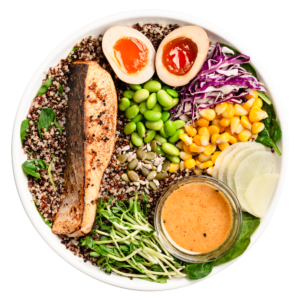Tuna San Salad, a culinary masterpiece by SaladStop!, delights palates with its medley of flavors and nourishing ingredients. This wholesome dish offers a appetizing experience, combining savory seared tuna with crisp greens and creamy avocado. With each bite, Tuna San Salad delivers both satisfaction and nutritional goodness. Now let’s discuss what makes this Salad a truly one of its kind.
What makes Tuna San Salad so good?
The Nutrient-Rich Foundation: Mixed Greens
At the core of this culinary masterpiece lies a bed of mixed greens, a nutrient-rich foundation bursting with vitamins, minerals, and antioxidants. Mixed greens, made of variety of leafy vegetables such as frisee, crystal and romaine lettuce, red and white cabbage, are low in calories but high in fiber, aiding in digestion and increases satiety. Moreover, these leafy greens boast an impressive array of vitamins, including vitamin K for bone health, vitamin A for vision, and vitamin C for immune function.
Protein Powerhouse: Seared Tuna
The seared tuna, the star of the Tuna San Salad, not only elevates the dish with its savory flavor but also delivers a hefty dose of protein. Protein is essential for muscle repair and growth, making it an indispensable component of any balanced diet. Additionally, tuna is rich in omega-3 fatty acids, known for their anti-inflammatory properties and their role in promoting heart health.
Creamy and Nutritious: Avocado
Accompanying the seared tuna are slices of creamy avocado, a superfood celebrated for its heart-healthy monounsaturated fats. Avocado is rich in potassium, a mineral crucial for maintaining healthy blood pressure levels and overall cardiovascular function. Furthermore, its velvety texture lends a delightful contrast to the crispness of the greens and the tender tuna.
Nutritional Powerhouse: Edamame
Edamame, the young soybeans nestled within the Tuna San Salad, are nutritional powerhouses in their own right. Bursting with plant-based protein, fiber, and an array of essential vitamins and minerals, edamame contribute to satiety while building muscle strength and bone health. Moreover, they contain phytoestrogens, plant compounds known for their potential to alleviate menopausal symptoms and reduce the risk of certain chronic diseases.
Bursting with Flavor: Cherry Tomatoes and Citrus
Complementing the mix are juicy cherry tomatoes, bursting with flavor and rich with antioxidants such as lycopene, which may help protect against certain types of cancer and promote heart health. The addition of orange not only enhances the salad’s vibrant citrusy notes but also provides a refreshing burst of vitamin C, boosting the immune system and supporting collagen production for healthy skin.
Crunchy Texture and Nutty Flavor: Sesame Seeds
A sprinkle of sesame seeds adds a delightful crunch to the Tuna San Salad while leaving a nutty aroma and flavor. Sesame seeds are rich in beneficial compounds, including lignans and phytosterols, which have been linked to improved heart health, reduced inflammation, and enhanced antioxidant activity.
Tantalizing Dressing: Wasabi Honey Soy
Finally, the salad is poured with a appetizing wasabi honey soy dressing, infusing each bite with a harmonious balance of sweet, savory, and spicy notes. While adding a burst of flavor, this dressing also contributes to the functional nutrition profile of the Tuna San Salad, providing a modest amount of healthy fats and a hint of wasabi’s sinus-clearing kick.
The SaladStop! Tuna San Salad is not merely a culinary delight but also a testament to the marriage of flavor and function. With its diverse array of nutrient-rich ingredients, from leafy greens and protein-packed tuna to creamy avocado and antioxidant-rich fruits, this salad exemplifies the art of nourishing the body while enticing the taste buds. Whether enjoyed as a wholesome meal on its own or as a refreshing accompaniment to any dining experience, the Tuna San Salad offers a harmony of flavors and a bounty of functional nutrition benefits to savor with every bite.




